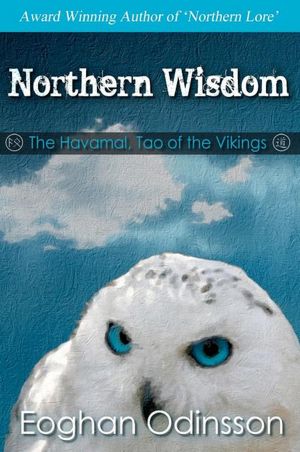
This one is interesting, a modernization of the Hávamál, the poems of the Vikings that most use these days as the starting point for a reconstruction of their religion. I’m not going to address the Hávamál directly since I don’t study it in a scholarly manner. Northern Wisdom takes the archaic language in many sections of the poem and reconstructs it in such a way that it’s easier to understand. The author did not do this alone however, he had help of others in this rewriting. He acknowledges the “crowd-sourcing” as part of the overall contribution to the book.
Some of it does strike me as somewhat interesting. For instance, substituting a car and the tires on the car for a reindeer when talking about moving over ice, is an interesting choice, and a relevant one. Many readers will relate more easily to a car with snow tires than a reindeer with unshod hooves. So that advice is more accessible to someone from the 21st century.
I am glad the author kept the translation with the modernized verse as it gives a more accurate “flavor” to the poems. Those of us who are used to archaic verse are able to actually go to the source and see how the modern verse would read when it was written.
Each verse is given its own page, and all commentary relating to that verse is on that page along with keywords to make it easy to search. For instance:
Modernized Verse 44
If you have a friend,
and know her to be loyal,
share your thoughts with her.
Exchange gifts and visit her often.
Keywords: Friendship, Confidante
Old Verse 44
If a friend thou hast whom thou fully wilt trust,
And good from him wouldst get,
Thy thoughts with his mingle,
and gifts shalt thou make,
And fare to find him oft.
pg 73
All the meaning is there in the modernized verse, and the language is clearer for modern vernacular, but you can see what the original verses had to say in the new. This is a massive step forward in my opinion.
That said, there is a long essay included in the front which presents the Hávamál to a group of Japanese. It was presented as a scholarly work in a class (all of which is explained in the introduction to the chapter). The explanation is that this is an immortal document and still relevant to now and how certain sections should not be taken seriously. But the essay draws many parallels between the Tao and the Hávamál
To put into context of the presentation, the contents are true and presented as fact, but as I read it, the content of the essay is made up of opinions, and that offends me. I always try to present facts as facts and note where I have opinions in my presentation. I probably would have moved this essay to the end of the book, rather than presenting it as the first thing read.
Also the title of the book changes. On the cover it states that the Hávamál is the Tao of the Vikings, but all internal references state that this is the Tao of the North. The north covers a lot more territory than Norway and Sweeden. I think the author needs to make up his mind, although I think it is too late to change the internal references.
All in all, a very good reference book for anyone who is wanting to understand more about the Northern Religions. It reads like the Colloquy of Two Sages from the Celtic revivals, and it is full of good advice for all. All in all, 4 stars out of 5
~review by: Erin
Author: By Eoghan Odinsson
Asgard Studios, 2012
$17.95
